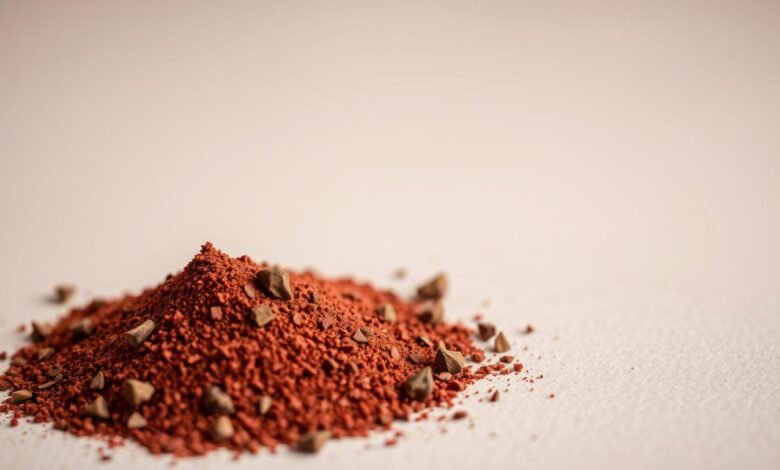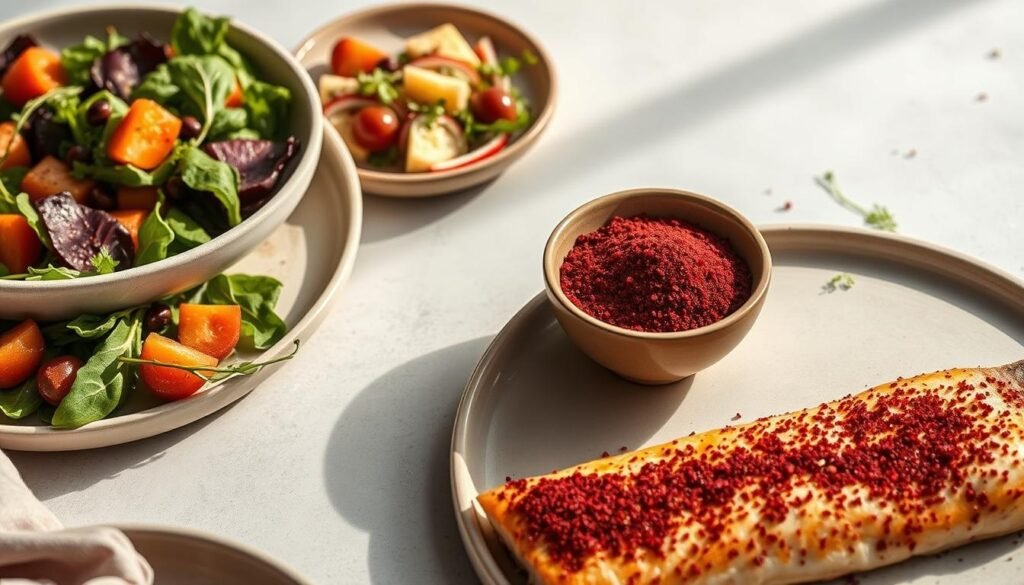
You’ve probably seen this vibrant crimson powder in Mediterranean restaurants or specialty food stores. This tangy red spice comes from dried berries of the Rhus Coriaria shrub. The name comes from the Arabic word “summaq,” which means “dark red.”
The flavor profile is unique. It offers bright, lemony notes with subtle smoky undertones. Sweet and earthy hints complete this complex seasoning, making it versatile in your kitchen.
This middle eastern seasoning has been treasured for centuries. The berries are dried, ground, and sifted to remove bitter seeds. What’s left is a coarse, flavorful powder that adds sophistication to recipes.
Whether you’re exploring Middle Eastern cuisine or trying new flavors, this ingredient is exciting. It opens up new culinary possibilities for home cooks.
Key Takeaways
- Derived from dried berries of the Rhus Coriaria shrub native to the Mediterranean region
- Name comes from Arabic “summaq” meaning “dark red,” reflecting its distinctive crimson color
- Offers a complex flavor profile with tangy, lemony notes and subtle smoky undertones
- Widely used in Mediterranean and Middle Eastern culinary traditions for centuries
- Versatile ingredient that enhances both traditional dishes and modern cooking applications
- Processing involves drying, grinding, and sifting berries to create a coarse powder
Understanding Sumac Spice: Origins and Basics
Sumac’s journey from wild shrub to beloved spice is fascinating. It started in ancient Mediterranean hillsides and now reaches kitchens worldwide. Its story blends traditional harvesting with centuries of cooking wisdom.
Knowing where sumac comes from helps you understand its unique taste. Learning how it’s processed helps in your cooking. Also, knowing the different types of sumac helps you pick the right one for your recipes.
What Is Sumac and Where Does It Come From
Sumac grows in the wild across the Mediterranean and Middle East. It thrives in rocky areas from Turkey to Lebanon. The spice comes from the rhus coriaria species, with small, bright red berries.
For over 2,000 years, ancient civilizations used sumac for food and medicine. Today, Turkey, Iran, and Syria are top producers of quality sumac.
Sumac belongs to the cashew family, Anacardiaceae. This explains its unique taste. The berries get their lemony flavor as they ripen.
The Rhus Coriaria Plant and Harvesting Process
The rhus coriaria plant is a deciduous shrub that grows up to 10 feet tall. It has compound leaves and fuzzy, red berries. The berries start green and turn deep crimson as they ripen in late summer.
Harvesting must happen at the right time for the best flavor. Workers pick the berries when they’re almost ripe. The berries need to be dry before processing starts.
The drying process is key to keeping sumac’s taste. Workers dry the dried sumac berries in the sun for days. Then, they grind and sift the berries to remove bitter seeds. This step keeps the flavor pure and lemony.
Different Types of Sumac Available
There are many sumac varieties, each with its own flavor. Sicilian sumac is very tart with a deep red color. Turkish sumac is milder, while Syrian sumac has a robust flavor and coarser texture.
Tanner’s sumac is another high-quality option. It’s named after its historical use in leather tanning. It has fine powder with consistent flavor.
Quality can vary a lot. Premium dried sumac berries have vibrant color and strong aroma. Lower-quality products may look dull and lack flavor.
Identifying the Distinctive Flavor Profile of Sumac
Sumac’s taste is unique, blending acidity with depth. This tart culinary herb offers a complex experience. Knowing its flavor helps you use it better in cooking.
Sumac’s tartness hits you first, then subtle undertones kick in. It’s more than just sour. This makes sumac a key spice in your collection.
Recognizing the Tangy and Lemony Characteristics
Sumac’s flavor is bright and tangy, like lemon zest. It’s refreshing yet warming. The tartness comes from natural acids in the berries.
As it lingers, you’ll find deeper notes. Tannic qualities add structure, like dry red wine. You’ll also taste fruity sweetness and smoky undertones, creating a balanced flavor.
Sumac’s acidity is softer than harsh ingredients. This makes it versatile and easy to use in many dishes without overpowering others.
Comparing Sumac to Other Tart Spices
Sumac adds acidity without a sharp bite. Its mellower acidity lets other flavors stand out. This is great for dishes where balance is key.
Tamarind is tart but sweeter and stickier. Sumac has a cleaner, brighter profile that doesn’t hide other tastes. It lasts longer in cooking without turning bitter.
How Processing Methods Affect the Flavor
Grinding sumac changes its flavor. Fine grinds release tartness quickly. Coarser grinds offer bursts of flavor and texture.
Removing seeds makes the flavor smoother. Seeds add subtle bitterness for complexity. Drying methods also impact flavor, with slower drying preserving more delicate tastes.
Fresh sumac has the brightest taste. As it ages, tartness fades, and earthy notes grow, offering new flavors for your dishes.
Choosing the Right Form of Sumac Spice for Your Kitchen
Knowing the different sumac forms helps you pick the best for your kitchen. Each type has its own benefits for mediterranean cooking. Whether you prefer ground or whole sumac depends on your cooking style and storage needs.
Ground Sumac Powder Benefits
Ground sumac is great for quick meals. It mixes well into marinades, dressings, and spice rubs without prep. Sprinkle it on dishes for a tangy flavor.
The powder dissolves fast in liquids, perfect for sauces and vinaigrettes. Sumac powder also measures well, giving consistent results in recipes. It’s often used in za’atar blends for even distribution.
Ground sumac is easy to store because it takes up less space. Its fine texture blends well with other spices in custom mixes.
Whole Dried Sumac Berries Applications
Whole sumac berries keep longer and taste fresher than ground sumac. You can grind them just before using for the best flavor. They stay potent for up to two years if stored right.
Whole berries add texture to your mediterranean cooking. Crush them lightly for a bit of crunch or grind them smooth. Some recipes like the texture of partially crushed berries.
You can also make sumac tea with whole berries. Just steep them in hot water for a tart drink.
Quality Indicators to Look For When Shopping
Good sumac is deep burgundy to reddish-purple. Avoid pale or brownish sumac, as it’s old or poorly made. Fresh sumac powder should feel slightly oily from natural oils.
Make sure the sumac label says it’s pure, without salt or fillers. Quality sumac has a strong, pleasant smell when you open it.
| Quality Factor | Good Quality | Poor Quality | Impact on Cooking |
|---|---|---|---|
| Color | Deep burgundy-red | Pale brown or gray | Affects visual appeal and flavor intensity |
| Aroma | Strong, tangy scent | Weak or musty smell | Indicates freshness and potency |
| Texture | Fine, slightly oily powder | Coarse or completely dry | Influences blending and dissolution |
| Ingredients | 100% pure sumac | Contains salt or fillers | Affects flavor balance in recipes |
Buy sumac from Middle Eastern markets, spice shops, or online. These places often have fresher products. Keep your sumac in airtight containers, away from light and heat, to keep its color and distinctive flavor profile vibrant.
How to Use Sumac Spice in Your Cooking
Learning to use sumac in your kitchen can make simple dishes taste amazing. This spice adds a bright, tangy flavor to any recipe. Knowing how to use it right will make your culinary sumac go further.
Sumac is easy to use. You don’t need fancy recipes or tools to enjoy it. It’s like a natural flavor booster, similar to lemon zest or vinegar.
Step-by-Step Guide to Incorporating Sumac
Start with simple uses to get used to sumac. Sprinkle a little on your morning avocado toast for a flavor boost. It pairs well with creamy foods.
For salads, mix sumac into your dressing. Use olive oil, a teaspoon of sumac, and a pinch of salt for a tasty vinaigrette. This makes a naturally tart dressing without vinegar.
When seasoning proteins, rub sumac on chicken or fish before cooking. It adds flavor and a nice red color. You can also dust it on grilled veggies before serving.
Soups and stews get a nice touch with a sprinkle of sumac. Add it to the bowl, not the pot, to keep its flavor bright. It’s great with lentil soups and vegetable broths.
Timing: When to Add Sumac During the Cooking Process
Timing is key for sumac’s flavor. Add sumac towards the end of cooking to keep its taste fresh. Heat can break down the oils that give sumac its unique taste.
For marinades, use sumac 30 minutes to 2 hours before cooking. This lets the flavors soak in without losing taste. Longer times can make sumac taste bitter.
When making rice or grains, add sumac after removing from heat. This releases the aromas without losing flavor. It keeps the taste in your dish.
Cold applications like yogurt dips or salads don’t need timing. You can add sumac anytime. These dishes get better as the sumac blends with other flavors.
Measuring and Dosage Guidelines
Using the right amount of sumac is important. Sumac uses vary, so start small and adjust to taste. This ensures your dishes don’t get too spicy.
Starting Amounts for Beginners
Begin with small amounts to get a feel for sumac’s flavor. For most dishes, start with 1/4 teaspoon per serving. This adds flavor without overpowering other tastes.
For proteins, use 1/2 teaspoon per pound. This works well for chicken, lamb, or salmon. Vegetables need less, about 1/4 teaspoon per cup.
For dressings and sauces, start with 1/2 teaspoon per 1/4 cup of liquid. You can always add more, but it’s hard to remove excess sumac once mixed.
Adjusting Flavor to Your Taste Preferences
Getting used to sumac takes practice and trying different amounts. Taste your dishes before adding more. The tangy flavor should enhance, not overpower, your ingredients.
If it’s too mild, add sumac in small amounts. Use 1/8 teaspoon at a time and taste between each addition. This helps avoid over-seasoning.
If you prefer stronger flavors, you can double the starting amounts. But remember, sumac’s acidity can become too harsh if used too much. Balance is key to using culinary sumac well.
| Food Type | Starting Amount | Maximum Recommended | Best Application Method |
|---|---|---|---|
| Proteins (per pound) | 1/2 teaspoon | 1 tablespoon | Rub before cooking |
| Vegetables (per cup) | 1/4 teaspoon | 1/2 teaspoon | Sprinkle after cooking |
| Salad Dressing (per 1/4 cup) | 1/2 teaspoon | 1 teaspoon | Mix thoroughly |
| Rice/Grains (per cup dry) | 1/4 teaspoon | 3/4 teaspoon | Stir in after cooking |
Remember, sumac’s flavor gets stronger over time. Dishes seasoned with sumac often taste better after resting for 10-15 minutes. This lets the spice fully mix with other flavors in your recipe.
Mastering Traditional Middle Eastern Applications
The Middle East’s rich food culture shows how sumac makes simple dishes taste amazing. It’s used in many ways, from being a main flavor to adding depth to spice mixes. Learning about these uses will make you appreciate sumac even more.
Cooks in the Middle East know how to balance sumac’s tartness with other flavors. It’s in everything from simple salad dressings to big feasts. Each place has its own way of using sumac, showing its unique taste.
Creating Za’atar Spice Blend with Sumac
Za’atar is a famous middle eastern spices mix, with sumac being a key za’atar ingredient. It’s made with ground sumac, thyme, toasted sesame seeds, and salt. The mix usually has two parts thyme to one part sumac, for a great taste.
To make za’atar at home, toast the sesame seeds first. This brings out their nutty taste and stops the mix from getting bitter. Mix everything well, so the sumac’s color spreads evenly.
Good za’atar should look vibrant and smell great. Keep your homemade blend in a sealed container, away from sunlight. It stays fresh for about six months if stored right.
Lebanese and Syrian Cooking Techniques
In Lebanon, sumac is key in dishes like fattoush salad, adding a tangy touch. Syrians use sumac in olive oil dressings for veggies, showing how it boosts flavors without overpowering them.
Mezze often includes sumac as a seasoning and garnish. Sprinkle it on hummus, baba ganoush, or labneh for a pop of color and taste. The vibrant red color looks great against white dips.
For grilled meats, Lebanese cooks use sumac in marinades. It tenderizes the meat and adds Middle Eastern flavors. Mix sumac with garlic, olive oil, and herbs for a true marinade.
Turkish and Persian Culinary Methods
In Turkey, sumac is in yogurt dips and sauces, cooling down spicy foods. The Turkish way is to mix sumac with yogurt, garlic, and herbs. This balances the spice’s tartness with the yogurt’s creaminess.
Persian cooking uses sumac in rice and kebabs. Iranians sprinkle sumac on saffron rice for color and taste. It also brightens up Persian herb stews.
Lahmacun, a Turkish flatbread, gets a tangy kick from sumac in the meat topping. Mix ground sumac with lamb, onions, and spices before spreading on dough. Sumac cuts through the meat’s richness, adding a true Middle Eastern flavor.
Exploring Modern Cooking Applications and Recipes

Today, sumac is a key ingredient in modern cooking. It turns simple dishes into something special. This middle eastern spice is loved by home cooks around the world.
Sumac’s beauty lies in its simplicity and color. Lebanese sumac adds stunning colors and complex flavors to meals. It makes cooking more exciting and flavorful.
Seasoning Meat and Poultry Dishes
Sumac makes meat and poultry dishes pop with color and flavor. Rub red sumac on grilled chicken for a mahogany crust. It adds a tangy taste.
Kofta kebabs are a great example of sumac’s use in meat. Mix it with ground lamb or beef for a tasty patty. It also enhances roasted lamb with a caramelized coating.
Try Mediterranean chicken nachos with sumac for a flavorful dinner. It adds depth without overpowering other tastes. Fish dishes also benefit from sumac’s lemony notes, especially with lemon juice.
Enhancing Vegetables and Salads
Vegetables get a boost from sumac. Roasting them with sumac creates caramelized, tangy edges. It keeps their colors bright and adds depth.
Salads are a canvas for sumac’s flavor. Fattoush salad is a classic example. Adding it to salad dressings also creates unique flavors.
Green salads look and taste better with a sprinkle of lebanese sumac. It adds a pop of color and clean flavors. Grain salads, especially with quinoa and bulgur, are enhanced by sumac.
Adding Flavor to Bread and Grain Dishes
Sumac changes bread and grains into gourmet dishes. It’s easy to elevate grain bowls and flatbreads with this spice.
Flatbread and Pita Topping Techniques
Flatbread toppings get a boost from red sumac. Mix it with olive oil and herbs for a tasty topping. Brush it on warm pita or naan for instant flavor.
Za’atar-inspired blends are great on focaccia and other breads. Combine sumac with thyme, sesame seeds, and salt for a homemade seasoning. It pairs well with olive oil.
Rice and Grain Bowl Seasoning Methods
Rice and grain bowls are brightened by sumac. Sprinkle it on rice pilaf for color and tang. It’s perfect for Middle Eastern grain bowls.
Quinoa bowls get a sophisticated touch with sumac. It cuts through rich ingredients like avocado and nuts. It’s also great in grain salad dressings.
| Dish Type | Application Method | Timing | Flavor Impact |
|---|---|---|---|
| Grilled Chicken | Dry rub before cooking | 30 minutes marinating | Tangy crust formation |
| Roasted Vegetables | Dust before roasting | Last 10 minutes of cooking | Caramelized tangy edges |
| Fresh Salads | Sprinkle just before serving | Immediately before eating | Bright acidic finish |
| Flatbread Toppings | Mix with olive oil | Applied to warm bread | Complex herbal notes |
| Grain Bowls | Final seasoning dust | After assembly | Brightens heavy bases |
Even desserts can be enhanced by sumac. A pinch of lebanese sumac on vanilla ice cream or strawberries is surprising yet delightful. It adds a tart contrast to sweet flavors, perfect for fruit preparations.
How to Purchase and Store Sumac Properly
Getting high-quality sumac is key to making your dishes pop. Making smart choices when buying and storing sumac ensures you get the most flavor. Whether you’re looking for a tangy spice or authentic ingredients, knowing where to shop and how to store sumac is crucial.
Finding Quality Sumac Sources
You can find real sumac spice at specialty stores and Middle Eastern markets in the U.S. These places have the freshest imports with vibrant color and potent aroma. Look for sumac in the spice section, often with other Middle Eastern items like za’atar.
Middle Eastern markets usually have the best sumac. The staff can help you find top brands and explain different grades. Many of these stores get sumac directly from traditional areas.
Online stores offer convenience and variety when local options are scarce. Pick reputable sellers who focus on Middle Eastern ingredients. Reading customer reviews helps ensure you get fresh, quality sumac.
Proper Storage Methods for Maximum Freshness
Keep sumac in an airtight container in a cool, dark spot. This keeps its color and flavor bright. Light, moisture, and air can quickly spoil sumac.
Use glass jars or sealed plastic containers for the best storage. Keep sumac away from heat and sunlight. A pantry or spice cabinet is perfect for long-term storage.
Don’t store sumac in the fridge, as moisture can cause clumps and flavor loss. Room temperature storage in proper containers keeps it fresh longer than refrigeration.
Determining Shelf Life and Freshness
Quality sumac stays fresh for up to one year when stored right. It should have a deep burgundy color and a bright, lemony smell. These signs help you check its quality quickly.
Buy pure sumac without salt or fillers for the best taste and longest shelf life. Always check the ingredient labels, as some blends have additives that can affect taste and shelf life.
Replace sumac when it turns brown or loses its aroma. Stale sumac won’t add the tangy punch your recipes need. When it loses its flavor, it’s time to get new sumac or try substitutes.
Finding Sumac Substitutes and Creating Alternatives

Smart home cooks know that finding effective sumac substitutes can save any recipe when this Middle Eastern spice is unavailable. While sumac offers a unique flavor profile, several alternatives can provide similar tangy results. This ensures you never have to skip a recipe due to missing ingredients.
The key to successful substitution lies in matching sumac’s distinctive tartness. Each alternative brings its own characteristics to dishes. Choosing the right replacement depends on your specific recipe and desired outcome.
Using Lemon Juice and Zest as Replacements
Lemon zest is the most popular sour spice alternative to sumac in home kitchens. It delivers comparable tartness and adds bright, fresh notes to dishes. However, lemon zest lacks sumac’s earthy undertones and distinctive tannic qualities.
When using lemon zest as a substitute, keep important cooking considerations in mind. Lemon zest can burn over high heat, making it better suited for finishing touches. Save it for garnishing completed dishes or add it during the final moments of cooking.
Fresh lemon juice works well in marinades and dressings where liquid additions won’t affect texture. Use approximately one teaspoon of lemon zest or two teaspoons of lemon juice to replace one teaspoon of ground sumac.
Other Tart Spices That Work as Substitutes
Several other ingredients can function as effective tart culinary herb alternatives when sumac isn’t available. Tamarind paste offers tangy flavor with a slightly sweet tropical twist, though it leans sweeter than sumac’s dry earthiness.
Vinegar provides sharp acidity but delivers more aggressive tartness than sumac’s subtle bite. White wine vinegar or apple cider vinegar work best, used sparingly to avoid overpowering dishes. Start with half the amount you would use for sumac.
Citric acid powder creates intense sourness without adding liquid to recipes. This concentrated option works well in dry rubs and spice blends where moisture control matters.
Making Your Own Tangy Spice Blends
Creating homemade sumac substitutes allows you to customize flavor profiles for specific dishes. Combine lemon zest with a pinch of paprika to add color and mild earthiness that mimics sumac’s appearance and complexity.
Try mixing equal parts dried lemon peel and mild chili powder for a balanced sour spice alternative. This combination provides tartness, color, and subtle heat that works well in Middle Eastern-inspired dishes.
For comprehensive guidance on sumac alternatives, explore detailed sumac substitutes that can transform your cooking when this distinctive spice isn’t available. Experiment with different combinations to find your preferred flavor balance.
Conclusion
Exploring sumac spice opens up a world of authentic flavors. It has been a staple in kitchens for centuries. This spice adds more than just tartness to your food.
It brings complexity, beauty, and cultural depth. Few spices can match its richness.
You now know how to pick quality sumac, store it right, and use it in many ways. You can add it to traditional za’atar blends or modern dishes. This makes your cooking more exciting.
Sumac is very versatile. You can use it on grilled meats, in marinades, or on salads. Each use brings out new flavors and connects you to old cooking traditions.
Adding sumac to your spice collection makes it more valuable. Its unique taste of tangy brightness and earthiness opens up new creative possibilities. It turns simple ingredients into amazing dishes.
Keep trying new ways to use sumac. As you get better, your dishes will impress everyone. They will bring a taste of the Middle East to your cooking.



